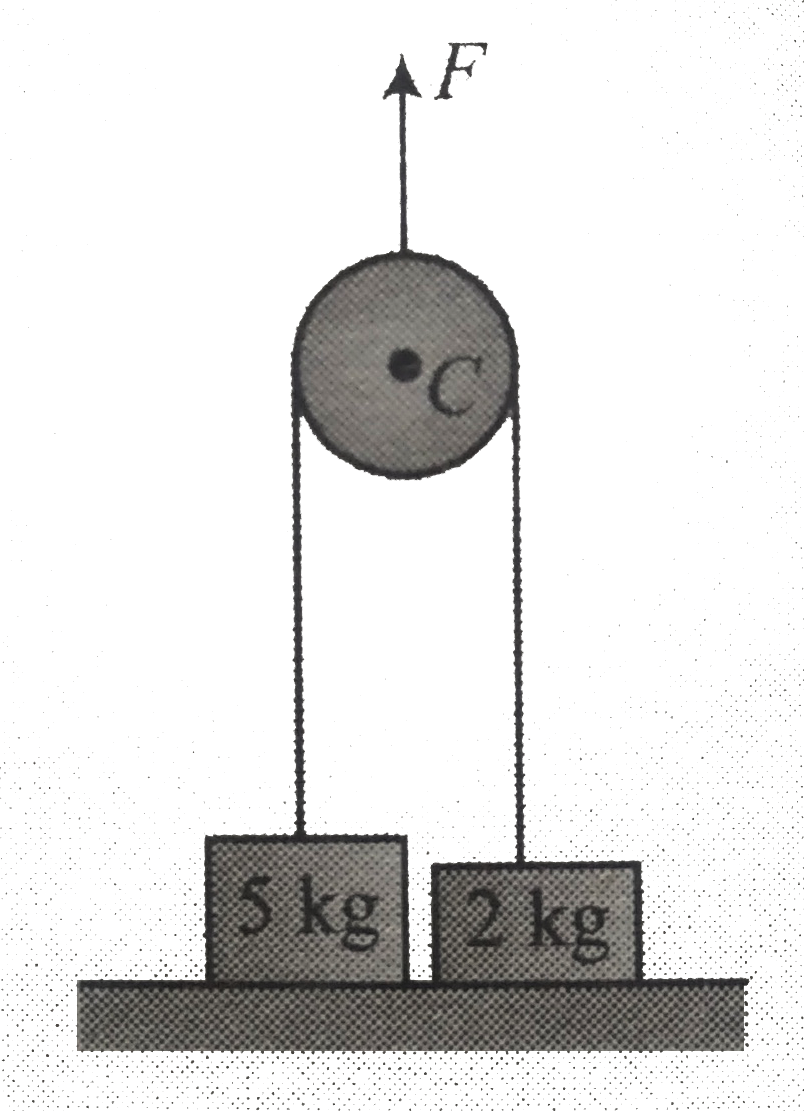Two blocks of masses 2kg and 5kg are at rest on ground. The masses are connected by a string passing over a frictionless pulley which is under the influence of a constant upward force F = 50 N. Find the accelerations of 5 kg and 2kg masses.
The masses will be lifted if the tension in the string is greater than the gravitational pull on masses.
Weight of 5kg mass =5×10=50N and that of

2kg mass =2×10=20N. From free body diagram 50−2T=0 or T = 25 N (∵ pulley is massless) Tension in each string = 25 N. 2kg weight will be lifted. But 5kg weight can not be lifted Acceleration of 2kg weight :
⇒25−20=2a or a=52=2.5ms−2
as the 5kg mass does not lifted, so its acceleration is zero.
Similar Questions
Two blocks of mass 2 kg and 5 kg are at rest on the ground. The masses are connected by a string passing over a frictionless pulley which is under the influence of a constant upward force F = 50N. The acceleration of 5 kg and 2 kg masses are

View SolutionTwo blocks of masses 5kg and 2 kg are initially at rest on the floor. They are connected by a light string. Passing over a light frictionless pulley. An upwards force F is applied on the pulley and maintained at a constant value. Calculate the acceleration a1 and a2 of the 5-kg and 2-kg masses, respectively, when F is (take g=10ms−2 )
(a) 30N, (b) 60N , (c) 140N
 .
.
View Solution
Knowledge Check
Two blocks of mass 2 kg and 5 kg are at rest on the ground. The masses are connected by a string passing over a frictionless pulley which is under the influence of a constant upward force F = 50N. The acceleration of 5 kg and 2 kg masses are
 A0,2.5m/s2B0, 0C2.5m/s2,2.5m/s2D1m/s2,2.5m/s2
A0,2.5m/s2B0, 0C2.5m/s2,2.5m/s2D1m/s2,2.5m/s2Two blocks of masses of 40 kg and 30 kg are connected by a weightless string passing over a frictionless pulley as shown in the figure.
 A0.7ms−2B0.8ms−2C0.6ms−2D0.5ms−2
A0.7ms−2B0.8ms−2C0.6ms−2D0.5ms−2Two blocks of masses of 40 kg and 30 kg are connected by a weightless string passing over a frictionless pulley as shown in the figure.
 A0.7ms−2B0.8ms−2C0.6ms−2D0.5ms−2
A0.7ms−2B0.8ms−2C0.6ms−2D0.5ms−2
Two blocks of masses 5kg and 2 kg are initially at rest on the floor. They are connected by a light string. Passing over a light frictionless pulley. An upwards force F is applied on the pulley and maintained at a constant value. Calculate the acceleration a1 and a2 of the 5-kg and 2-kg masses, respectively, when F is (take g=10ms−2 )
(a) 30N, (b) 60N , (c) 140N
 .
.
View SolutionTwo blocks of masses 3 kg and 6 kg are connected by a string as shown in the figure over a frictionless pulley. The acceleration of the system is

View SolutionTwo masses of 4 kg and 5 kg are connected by a string passing through a frictionless pulley and are kept on a frictionless table as shown in the figure. The acceleration of 5 kg mass is

View SolutionTwo masses of 8 kg and 4 kg are connected by a string as shown in figure over a frictionless pulley. The acceleration of the system is

View SolutionTwo masses of 8kg and 4kg are connected by a string as shown in figure over a frictionless pulley.The acceleration of the system is

View Solution
